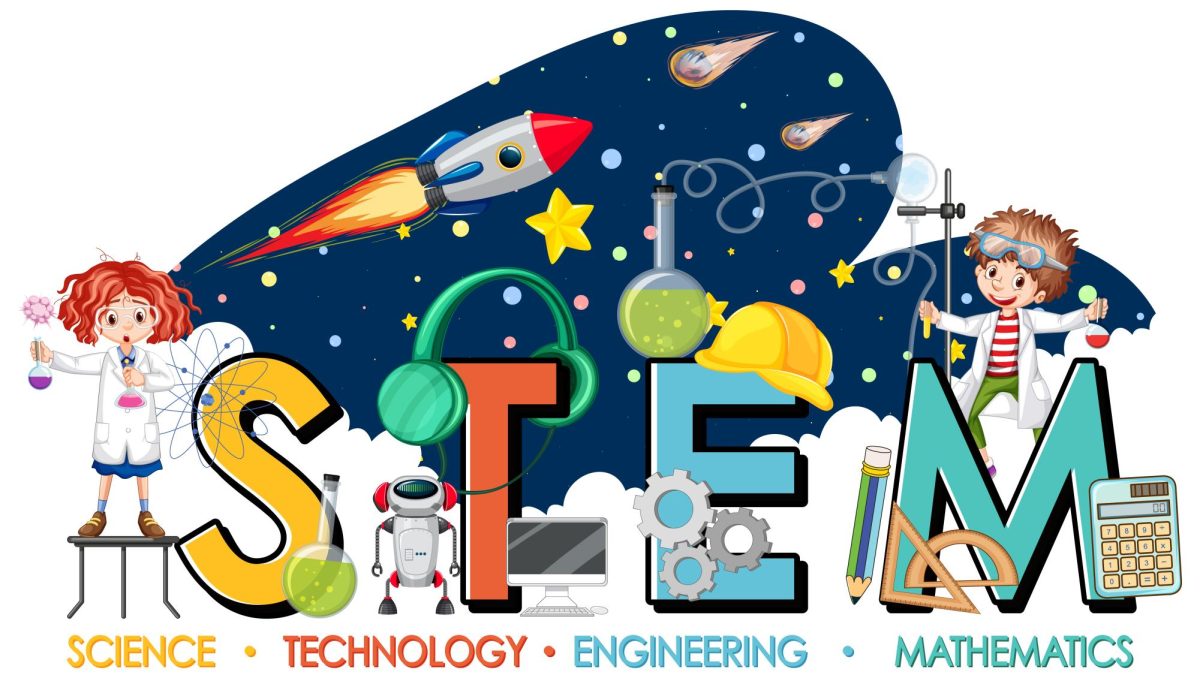Four years ago, in her freshman year, senior Penny O’Meara cooked marshmallows with a solar cell during Biology class.
If this activity doesn’t sound familiar, it’s because it shouldn’t. Penny wasn’t taking just any Biology course; she was taking STEM (science, technology, engineering, and math) Biology. Students like Penny—STEM students—get to experience something unique that others can’t find in typical core classes. They are immersed in a collaborative, project-based learning environment every single day.
“When I’m filling out college applications, I can say I’ve done these things that I don’t think many other students have done in high school,” Penny said. “They’re unique to the [STEM] program.”
STEM students participate in a soap-making business, which combines chemistry and mathematics to effectively craft and market handmade soap. Penny appreciated the real-world applicability of this project; she helped to market her company’s soap, expanding her knowledge in a field that she might pursue in college.
Other students, like junior Cari Shaffer, enjoy the challenge of the robot-operated vehicle (ROV) assignment, where individuals must build an ROV that will withstand many tests at the aquatic center—that’s right, students are crafting robots that are, essentially, going for a swim.
“It’s just you and your group, and you build an ROV, and you test it,” Cari said. “I don’t know if it’s intimidating, but it’s a lot to wrap your head around.”
In STEM, students build more than just ROVs and successful soap-making companies—students also build unbreakable bonds. Penny and her teachers share stories about their lives that make classes feel more personal; she knows a little bit about their families, and they know a little bit about hers.
“It’s just nice because you really get to know these teachers,” Penny said. “It’s a very close-knit community, and I’m very grateful.”
Cari and Penny agree that STEM takes a lot of work; while some aspects of it aren’t too challenging, a good work ethic is needed to succeed.
“You have to do work outside of school, and you have to be thinking about things independently,” Penny said. “It’s not a class where you’re going to be given directions for everything you want to do.”
STEM is unlike traditional classes due to the quantity of project-based assignments and the high-level thinking skills students need to master to succeed. Achievement depends on an individual student’s self-discipline; the less effort students put in, the less successful they are.
Some STEM students, like sophomore Gavin O’Meara, believe that these differences between STEM and traditional core classes can be too difficult for some students.
“I don’t think it’s for everyone,” Gavin said. “You have to know that it’s more work than usual. It’s not an insane amount of work, but it is an advanced thing.”
STEM classes are held at Northern, so non-Northern students commute to classes daily. Juniors leave FHC in the morning and come back halfway through the day; freshmen, sophomores, and seniors leave around lunchtime and return at the end of the day.
While the school provides students with a shuttle bus, transportation has proven to be a significant obstacle in taking STEM.
“The problem is that it is very easy for the bus to leave without us,” Penny said. “We also miss our lunch, so we have to eat on the bus, and during COVID-19, [when I first took STEM], that was a big no-no.”
Cari experienced her own bout of stressors at the beginning of the year as they were figuring out transportation; however, scheduling conflicts between band, other science classes, and STEM have proved more difficult to manage than an unreliable bus.
“Band is a huge part of my life,” Cari said. “AP Chem is something I want to take, or KCTC, and I can’t do all of those things [and STEM] all together. There’s no way around it.”
This predicament is, unfortunately, a notable one for many students, explaining why so few take STEM classes.
Still, STEM features a hands-on, experimental curriculum that teaches students how to combine science, technology, engineering, and math concepts to solve problems. So, if scheduling and transportation aren’t an issue, students should consider joining.
“[STEM gives you] a big advantage coming out of high school and getting into college or going right into a job,” Gavin said. “I have business experience [because of STEM]. I’m that much farther ahead than a lot of other people.”
For those who can handle the responsibilities of a more advanced curriculum, STEM is a great option. It’s heavily project-based and students collaborate to design solutions to real-world situations.
“I would recommend [STEM] if you want a community where you can express yourself more,” Penny said. “It [also] provides an advantage for college preparedness, and I think that’s what really makes it unique.”




























































































